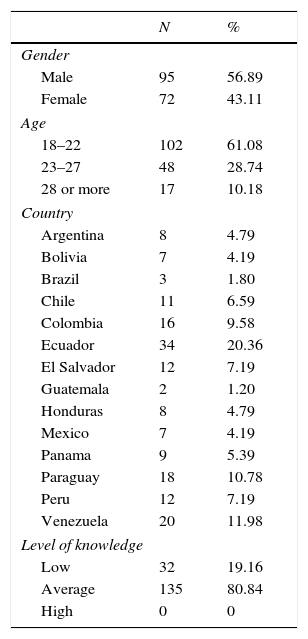According to the data reported by the World Health Organization (WHO), vector-borne diseases currently make up more than 17% of all infectious diseases.1 Up to 2014, approximately, the dengue virus (DENV) was the only infection transmitted by the Aedes aegypti mosquito. But from 2015 onwards, there have been an important number of Chikungunya virus (CHIKV) cases and, as another arbovirus causing important infections,2 the Zika virus (ZIKV) has also shown its first reported cases of infection in Brasil and Colombia.3
To the effect of knowing the level of knowledge that the Latin American students of medicine have on these viruses, a transversal observational study was performed via videoconference on DENV, ZIKV and CHIKV epidemiology in Latin America, Organized by the Standing Committee on Medical Education of the American Federation of Scientific Societies of Medical Students (or FELSOCEM, by its Spanish acronym). A questionnaire using Google Docs was designed to collect the information, with 19 questions divided into 2 sections. The first 4 asked about sociodemographic variables, and the second 15 asked about the students’ level of knowledge. A score of 0–8 was considered a low level of knowledge, a score of 9–13 was considered an average level of knowledge, and a score of 14 or 15 was considered a high level of knowledge. One hundred and sixty eight randomly selected medical students participated in our videoconference study. 20.36% (34) were from Ecuador, 11.98% (20) were from Venezuela, and 10.78% (18) were from Paraguay, the largest age group was from 18 to 22 years old, and the majority of the participants were male (56.89%, 95) The predominant level of knowledge was average (80.84%, 135) (Table 1). All of the participants knew the preventative measures and the methods to combat the vector, and the lowest percentage of successful answers were to the questions on general signs and symptoms.
General characteristics of the medical students participating in the videoconference, February 2016.
| N | % | |
|---|---|---|
| Gender | ||
| Male | 95 | 56.89 |
| Female | 72 | 43.11 |
| Age | ||
| 18–22 | 102 | 61.08 |
| 23–27 | 48 | 28.74 |
| 28 or more | 17 | 10.18 |
| Country | ||
| Argentina | 8 | 4.79 |
| Bolivia | 7 | 4.19 |
| Brazil | 3 | 1.80 |
| Chile | 11 | 6.59 |
| Colombia | 16 | 9.58 |
| Ecuador | 34 | 20.36 |
| El Salvador | 12 | 7.19 |
| Guatemala | 2 | 1.20 |
| Honduras | 8 | 4.79 |
| Mexico | 7 | 4.19 |
| Panama | 9 | 5.39 |
| Paraguay | 18 | 10.78 |
| Peru | 12 | 7.19 |
| Venezuela | 20 | 11.98 |
| Level of knowledge | ||
| Low | 32 | 19.16 |
| Average | 135 | 80.84 |
| High | 0 | 0 |
There have been many studies whose objective were to measure the level of knowledge of the dengue virus, but there are few to none with the same objective for the Zika or the Chikungunya viruses. The results found on the level of knowledge of DENV were similar to those found by Hernandez et al.4 where the predominant result was average. While the medical students’ overall level of knowledge was average, it is important to note that there were no students with a high level of knowledge of these 3 arboviral pathologies, so extracurricular activities, such as conferences and educational talks, are of utmost importance in the students’ comprehensive training and knowledge of emerging pathologies, which can affect the Latin-American countries very frequently.
FundingNo financial support was provided.
Conflict of interestThe authors have no conflicts of interest to declare.




